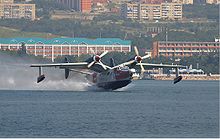Gull wing

Gull wing (English: gull wing , French: aile en mouette - each in German: seagull wing ) are a type of aircraft in which the wings - viewed from the longitudinal axis - are designed in a V-shape on both sides of the fuselage, i.e. a "kink" exhibit.
Construction variants
- In the basic variant, the two outer wing sections usually run more or less horizontally, the relatively short inner wings form a "V". One example is the DFS Habicht .
- The Puławski wing , which can be found on the PZL P.11 , is a special form of the gull wing construction in which the construction is designed as a shoulder wing .
- Another construction variant has inner wings sloping downwards from the fuselage, i. that is, they form an "inverted V". The outer wings are almost horizontal ( Chance Vought F4U ) or rise again significantly towards their ends ( Ju 87 ).
- The wing position with horizontal inner wings and relatively short, upwardly bent outer wings have the classic light aircraft from the Jodel company, such as the Jodel D140 and models derived from it such as the Robin DR 400 .
Not to be confused with the latter variant is the winglet , which occasionally also appears at the end of a gull wing. This is the case , for example, with FA Smaragd .
Use

Gullwing should give the aircraft greater lateral stability, especially when cornering. Further reasons for the use of gull wing wings in connection with different arrangement of the height of the wings can be better visibility, shorter landing gears or higher-lying engines (on seaplanes). Occasionally, a higher fuselage (with the "inverted V") is mentioned to improve the safety of the passenger cabin in a belly landing ( Bartini Stal-7 ).
Historical development
The first use of a gull wing in the Weltensegler glider led to a fatal crash on the Rhön in 1921 due to a broken wing due to a faulty construction (see: Fliegerdenkmal (Wasserkuppe) ). After that, this construction method was initially not pursued any further until it was taken up again at the end of the 1920s in Poland (powered aircraft by Zygmunt Puławski ) and then in Germany (gliders by Alexander Lippisch ). The construction method, which was relatively complex for the time, experienced the peak of its spread in the 1930s and 1940s. The first successful German aircraft with gull wings was the high-performance glider Fafnir , the best known was the dive combat aircraft Ju 87. With today's calculation and production methods, much more elaborate wing shapes can be produced.
literature
- K. Anders and H. Eichelbaum: Dictionary of aviation . Quelle and Meyer, Leipzig 1937.
- Heinz A. F. Schmidt: Meyers Taschenlexikon Luftfahrt . 2nd, improved and enlarged edition. Bibliographisches Institut Leipzig, 1967, p. 204 (keyword gull wing ).
Individual evidence
- ^ Wilfried Copenhagen : transpress Lexicon aviation . 4th, revised edition. Transpress, Berlin 1979, p. 321 (keyword gull wing ).
